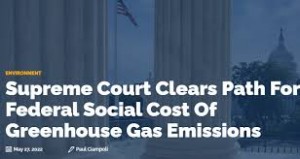From an Article by Niina H. Farah, E & E News, May 26, 2022
In a reprieve to the Biden administration, the Supreme Court today allowed federal agencies to continue using a climate metric important to rulemaking.
The justices issued an emergency order denying an application from a coalition of states led by Louisiana’s Republican Attorney General Jeff Landry to block use of the interim social cost of greenhouse gases, which puts a dollar value on avoiding harmful emissions.
The high court did not offer any explanation for its order, which came through its emergency docket, sometimes referred to as the “shadow docket.”
Biden officials had warned of wide-ranging impacts of blocking the metric, which federal agencies use to demonstrate the climate benefits of more stringent rulemaking or to assess the impacts of major projects.
The federal government’s current estimate of the social cost of greenhouse gases marks a significant shift from the much lower values adopted by the Trump administration. President Joe Biden’s team returned to values used under former President Barack Obama, adjusted for inflation. For carbon, that estimate is now about $51 per metric ton of emissions, compared to about $1 per metric ton under former President Donald Trump.
Landry and a coalition of Republican attorneys general had sought emergency aid from the justices after the 5th U.S. Circuit Court of Appeals temporarily blocked a February injunction from a lower court that barred the Biden administration from using the social cost of greenhouse gases.
The 5th Circuit order had allowed the metric to remain in use as a three-judge panel considers the Biden administration’s appeal of the ruling from the U.S. District Court for the Western District of Louisiana (E&E News PM, April 28).
The Supreme Court’s decision means the injunction blocking the metric will not go back into effect.
#######+++++++#######+++++++#######
See Also: Opponents warn of ‘chaos’ as Supreme Court revives water permit rule, E & E News, April 6, 2022
The Supreme Court’s decision today to reinstate a controversial Trump-era Clean Water Act permitting rule is raising concerns that states’ and tribes’ hands could be tied in how they review — and possibly deny — permits for everything from pipelines and mines to dams.
The court, without explanation and over the objection of four justices, put back in place a rule EPA finalized under the Trump administration tied to Section 401 of the Clean Water Act that bars states and tribes from considering issues not directly related to water quality — like climate change — when denying water permits (Greenwire, April 6).
Today’s order brings back the Trump rule, pending the outcome of litigation in the 9th U.S. Circuit Court of Appeals, and notes that the parties can bring back the matter for fuller Supreme Court review if necessary. The rule in dispute emerged in 2020 as former President Donald Trump made moves to boost the oil and gas sector. A federal district court judge last year struck down the regulation.
A spokesperson for EPA said the agency is reviewing the court’s order and moving forward with a rulemaking to “restore state and Tribal authority to protect water resources that are essential to public health, ecosystems, and economic opportunity.” While environmental groups criticized the court’s decision, oil and gas, and hydropower boosters applauded it, saying that permits have been delayed and denied without the rule in place.
Moneen Nasmith, a senior attorney at Earthjustice, which is representing a number of tribes and environmental groups in the case, told E&E News that there was “chaos” when the Trump-era rule was in place and that the decision from the Supreme Court’s conservative supermajority to reinstate the regulation shows “disregard for the integrity of the Clean Water Act and undermines the rights of Tribes and states to review and reject dirty fossil fuel projects that threaten their water.”
The Trump rule, she said, changes the delicate balance between the federal government and states that has existed for 50 years under the Clean Water Act and attempts to limit which projects are subject to review under Section 401 of the law, language that gives states and tribes the ability to review proposed projects’ effects on water quality. As an example, Nasmith said the rule tries to limit reviews to projects that are considered point sources of pollution. The rule also attempts to limit the type of information that can be asked of applicants and the basis upon which states can deny permits, as well as the conditions states can impose on permit applicants.
“There are ways that states and tribes are possibly not going to be able to protect their water quality when you don’t have direct discharge,” she said. “That’s very contrary to how much of this law has been interpreted for decades.”

